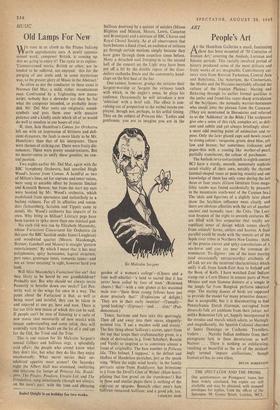ART
People's Art
AAr the Hamilton Galleries a small, fascinating .1,show has been mounted of '30 Centuries of Iranian Art,' covering the Amlash, Luristan and Islamic periods. This racially involved period of history produced some of the most delicate and lively works of art imaginable. Contributory cul- tures stern from Russian Turkestan, Central Asia and Babylonia. The Assyrians, the Cimmerians, the Medes and the Persians ineyitably affected the culture of the Iranian Plateau : blazing and flickering through its earlier formal qualities is the antler and frond-like razor-sharp articulation of the Scythians, the nomadic warrior-horsemen who swept onto the plateau from the Caucasus. (They are mentioned in Herodotus and referred to as the 'Ashkenaz' in the Bible.) The sculptures give one a sense of this rich, complex art, so deli- cate and subtle and yet always bristlingly alive: a most odd meeting point of animation and re- pose. Only the later glazed cups and bowls resort to strong colour : turquoise, green, deep blue, yel- low and brown; but sometimes iridescent, and paper-thin with a coating like mother-of-pearl, partially translucent, the colour of parchment.
The Amlash terra-cottas (ninth to eighth century BC) have a sturdy, smooth, immensely sophisti- cated vitality of their own, notably the rhytons (animal-shaped vases or pouring vessels) and our knowledge of them has only come during the last three or four years. (Grave furniture from mega- lithic tombs was found accidentally by peasants in the mountains south-west of the Caspian Sea.) The idols and figurines of a slightly later phase show the Scythian influence most clearly and there are obvious affinities with the art of another ancient and nomadic race : the Celts. The Luri- stan bronzes of the eight to seventh centuries BC are filled with this serpentine (but totally un- reptilian) sense of design which comes clearly from animals' horns, antlers and hooves. A final parallel could be made with the remote art of the Sepik river tribes in Northern New Guinea : think of the precise curves and spiky convolutions of a sea-horse and you are near the common de- nominator. To digress : one of the most moving (and occasionally untrustworthy) attributes of all folk art are the recurrent characteristics Which unify it all, from South-East Asia to Ireland and the Book of Kells. I have watched Zuni Indians stamp out a Corn Dance in remote parts of New Mexico and seen Siamese dancers at a temple in the jungle far from Bangkok perform identical steps. The mating dances of birds are supposed to provide the model for many primitive dances: that is acceptable, but it is disconcerting to find Pennsylvania Dutch (German, corrupted from Deutsch) folk art emblems from their faktur, not
unlike Bohemian folk art, happily incorporated in the reredos and murals which adorn, so blazingly and magnificently, the Spanish Colonial churches at Santo Domingo or Cochatee. Travellers, traders . . . Navaho Indian emblems from their
pictograms lurk in these decorations as well. Natives . . . There is nothing so exhilarating, touching or beautiful as the art of the mislead- ingly termed 'impure civilisations,' though Iranian art has its own ethos.
BRYAN ROBERTSON






























 Previous page
Previous page